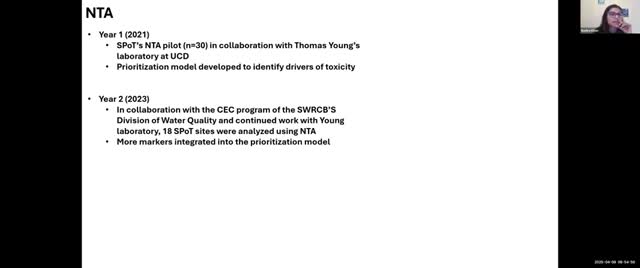Researchers analyze 18 urban sites revealing diverse chemical fingerprints in toxicity study
April 26, 2025 | California Water Quality Monitoring Council, Boards and Commissions, Executive, California
This article was created by AI summarizing key points discussed. AI makes mistakes, so for full details and context, please refer to the video of the full meeting. Please report any errors so we can fix them. Report an error »

In a recent meeting held by the California Water Quality Monitoring Council, officials gathered to discuss the ongoing efforts in water quality monitoring and the expansion of their non-targeted analysis (NTA) program. The atmosphere was charged with anticipation as members reviewed the progress made over the past few years and outlined plans for 2025.
This year, the council selected 18 sites for analysis, continuing a strategic approach that began in 2021. The focus has been on enhancing the dataset for NTA by incorporating more markers of toxicity. In 2024, the council had already sampled 18 sites, including six from Region 1, and the data collected has been pivotal in understanding the chemical complexities present in various urban environments.
As the meeting progressed, the discussion turned to the findings from the pilot studies. It was noted that as urban land use increases, so does the number of chemical features detected in sediment samples. This correlation was not surprising to the council, as urban areas typically harbor a wider array of pollutants. The complexity of chemical fingerprints revealed through NTA has provided deeper insights into the unique toxic profiles of different regions.
One significant point raised was the disparity in toxicity patterns between Region 2 and Region 4. The council clarified that these differences likely stem from the distinct "chemical soup" present in each area, a conclusion supported by both targeted and non-targeted analyses. The principal component analyses (PCAs) showcased during the meeting illustrated these variations, highlighting how urban sites in Region 4 exhibited markedly different chemical signatures compared to those in Region 2.
As the meeting drew to a close, the council emphasized the importance of these findings in shaping future water quality monitoring strategies. The results from 2021 are currently being compiled into a manuscript, with hopes of submission in the coming months. This ongoing research not only enhances the understanding of water quality issues but also informs policy decisions aimed at protecting California's vital water resources. The council's commitment to expanding its NTA work signals a proactive approach to addressing the complexities of water quality in an ever-evolving urban landscape.
This year, the council selected 18 sites for analysis, continuing a strategic approach that began in 2021. The focus has been on enhancing the dataset for NTA by incorporating more markers of toxicity. In 2024, the council had already sampled 18 sites, including six from Region 1, and the data collected has been pivotal in understanding the chemical complexities present in various urban environments.
As the meeting progressed, the discussion turned to the findings from the pilot studies. It was noted that as urban land use increases, so does the number of chemical features detected in sediment samples. This correlation was not surprising to the council, as urban areas typically harbor a wider array of pollutants. The complexity of chemical fingerprints revealed through NTA has provided deeper insights into the unique toxic profiles of different regions.
One significant point raised was the disparity in toxicity patterns between Region 2 and Region 4. The council clarified that these differences likely stem from the distinct "chemical soup" present in each area, a conclusion supported by both targeted and non-targeted analyses. The principal component analyses (PCAs) showcased during the meeting illustrated these variations, highlighting how urban sites in Region 4 exhibited markedly different chemical signatures compared to those in Region 2.
As the meeting drew to a close, the council emphasized the importance of these findings in shaping future water quality monitoring strategies. The results from 2021 are currently being compiled into a manuscript, with hopes of submission in the coming months. This ongoing research not only enhances the understanding of water quality issues but also informs policy decisions aimed at protecting California's vital water resources. The council's commitment to expanding its NTA work signals a proactive approach to addressing the complexities of water quality in an ever-evolving urban landscape.
View full meeting
This article is based on a recent meeting—watch the full video and explore the complete transcript for deeper insights into the discussion.
View full meeting
